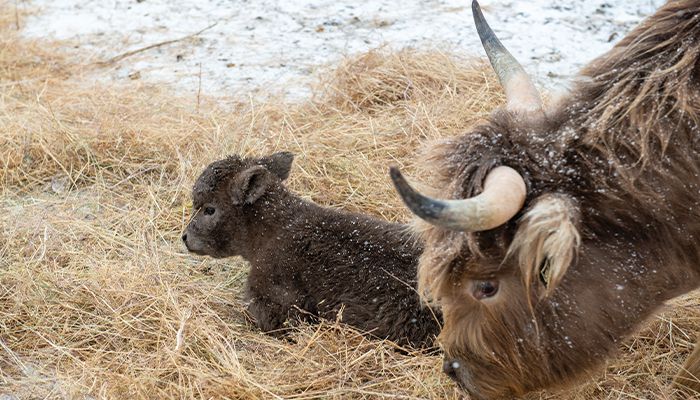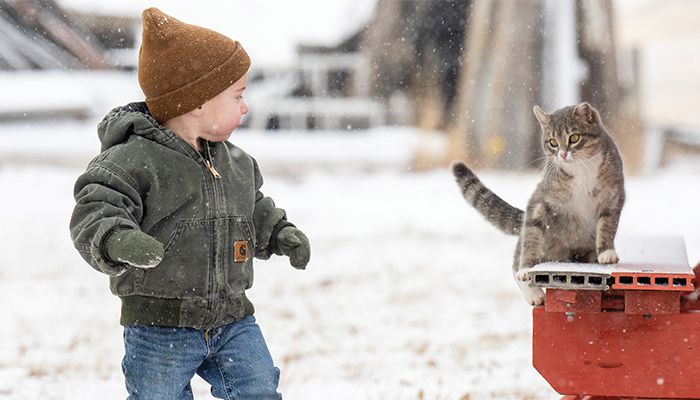Not your typical herd
Author
Published
1/2/2024
Home on the Iowa range. What's not to love about Scottish Highland cows? Those pretty eyes! Those bangs!
Scottish Highland cattle don’t just live in Scotland. And they don’t just adorn artwork and social media memes.
The Scottish Highland breed is a producer of quality beef. Mud Ridge Ranch raises a herd of 40 Scottish Highlands in southwest Iowa.
“We get people driving by just to look at them,” says Matt Vermeersch, a Farm Bureau member and owner of Mud Ridge Ranch in Red Oak.
Mud Ridge Ranch was honored as a finalist for Iowa Farm Bureau's 2023 Grow Your Future Award, honoring young entreprenuers in rural Iowa.
“It’s not your typical livestock,” says Vermeersch.
But then, Vermeersch isn’t your typical farmer.

Pictured above: Farm Bureau members Matt and Jocelyn Vermeersch, with their young sons Cam and Boone. PHOTO BY CONRAD SCHMIDT
Finding his way
Vermeersch didn’t grow up on a farm. His grandparents farmed, but retired when he was young. His father, a veterinarian, and his mother, a bank ag loan officer, lived and raised their family in Danbury.
Vermeersch wanted to farm but didn’t see a path at first. He went to Iowa State University, earning a degree in mechanical engineering. “Designing a tractor was the next best thing to driving one,” he says.
He met his wife, Jocelyn, and they bought a 5-acre tract on the edge of Council Bluffs near her family.
“To be honest, the first year, it sucked,” says Vermeersch. “Lots of mowing.”
Lesson learned. They got a few goats to help keep the grass down.
They also learned another lesson. They liked caring for animals. And the goat kids were fun.
“We just fell in love with caring for the animals,” says Vermeersch.
However, 10 goats weren't enough to earn an income. So they added larger farm animals — four Scottish Highland cows.
Today, those first Highlands have become a herd of 40. Ten goats have grown to 200.
Mud Ridge moved last fall from the Council Bluffs acreage to a farm near Red Oak. Vermeersch will transition the existing cropland to pasture for grazing. The farm also comes with outbuildings; their former Council Bluffs site offered no room for expansion due to land values on the city’s edge.

PHOTO BY CONRAD SCHMIDT
Not a hobby
Mud Ridge was a hobby farm until a friend introduced Matt and Jocelyn to Goats on the Go. “I was sold in one conversation,” says Vermeersch. “It tripled our business in three years.”
Goats will eat anything. Your trash, your laundry, your homework. They will also eat noxious weeds, brush and invasive plant species.
Around 2015, Story County farmer Chad Steenhoek, and then partner Aaron Steele, discovered using goats for natural brush control could be profitable. They formed Goats on the Go, managing herds of goats through brush-clearing projects in parks, farms and wooded areas, and inaccessible terrain.
The business grew. Now owned by Steenhoek, it consists of more than 70 affiliate goat producers across the U.S.
Vermeersch also sells some goats for meat. The U.S. is a net importer of goat meat, and Vermeersch is in the learning phase of goat breeding.
With the goats holding up their end of the farm’s bottom line, the cattle operation, too, needed to expand.
Matt and Jocelyn liked the Scottish Highland breed for its picturesque beauty, docility and maternal characteristics.
“They’re sort of the poster child for the re-romanticism of homesteading,” says Vermeersch.
They’re also good beef cattle that produce a lean meat that is “lower cholesterol, higher iron, higher protein and nutrient dense," Vermeersch says.
Originating as mountain cattle, Scottish Highland cattle perform well on a grass-fed diet.
Vermeersch sells most of the beef directly to customers.
“It was challenging getting started and finding customers,” he says. He is developing a marketing partnership with two other Scottish Highland breeders, increasing reach and inventory.
“It’s all about getting in front of the customer,” says Matt.
Mud Ridge Ranch makes prolific use of social media, a dream home for their photogenic animals.
“People buy from you because of your story. They want to know who you are, what you do. They want to see your best days and your tough days.”
Vermeersch likes the idea of skipping the middleman to sell beef direct to consumers: “Why not support the neighbor next door?”
The change in marketing options has opened the door for producers like Vermeersch to help fill those gaps and to increase the diversity of products grown on Iowa’s farms.
“Ag looks different everywhere,” he says. “I’ve grown sunflowers in California; green beans, peas and sweet corn in Idaho. How it looks for others isn’t how it has to look for you. Ag can be anything. Don’t be afraid to try something different.”
Queck-Matzie is a freelance writer from Greenfield.

PHOTO BY CONRAD SCHMIDT
Want more news on this topic? Farm Bureau members may subscribe for a free email news service, featuring the farm and rural topics that interest them most!